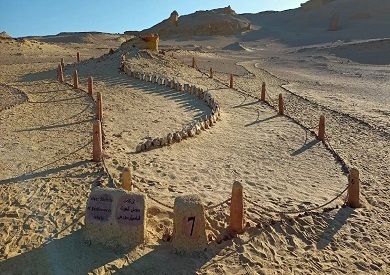
$50bn SDG-targeted investment proposals at SDG Investment Fair
Over 100 SDG-aligned projects with a total investment scope of $ 50 billion have been presented during the ...

Environment Minister Yasmine Fouad announced on Sunday that Egypt will build its first green road in Wadi Hitan (the Valley of Whales) in Fayoum which was included in the Green List of the International Union for Conservation of Nature (IUCN) in 2018.
This falls within the ministry’s plan to upgrade natural reserves in accordance with international systems to maintain natural resources and magnify available opportunities for economic and social development, the minister said, noting that this would promote environmental tourism in Egypt.
The 34-kilometer-long road will depend on a new way of recycling as it will use special emulsions to mix them with the soil and pave the road using modern technologies for recycling and adopting environmental methods that can cut greenhouse gas emissions and reduce noise. This, however, would not affect the natural color of the soil.
The minister said this road will be an icon for the optimal way of recycling and building green roads in view of the entailed environmental benefits, topped by maintaining resources by recycling them and saving raw material.
She added that this will help spread the culture of building green roads and protecting the environment in a way that will integrate with the march of development.
The minister voiced hope that natural reserves development will mark a starting point for sensitizing people about the importance of maintain natural reserves.
She added that this will also highlight the pivotal role which youth, community and environmental business partners should play in protecting the environment and biological diversity for the coming generations.
Wadi Hitan is the most important site in the world to demonstrate one of the iconic changes that make up the record of life on Earth; the evolution of the whales. It portrays vividly their form and mode of life during their transition from land animals to a marine existence.
It exceeds the values of other comparable sites in terms of the number, concentration and quality of its fossils, and their accessibility and setting in an attractive and protected landscape.
Wadi Hitan includes an iconic assemblage of fossilized skeletons of Archaeoceti (primitive whales documenting cetacean transition to marine life), sirenians and reptiles, as well as shark teeth from Gehannam Formation (40-41 million years ago). The Strata in Wadi Al Hitan belongs to Middle Eocene Time and it contains extensive mass of vertebrate fossil within 200 km2.
The World Heritage property is a strictly protected zone. It is an exceptional global reference site because of the number, concentration, quality and accessibility of the evidence of the earliest whales, often in the form of complete skeletons, and the record of the environment that they lived in.
Wadi Hitan is of sufficient size to include the main exposures of rocks where the whale fossils are found, as well as associated geological features of interest. In addition, a wider part of the Wadi El-Rayan Protected Area is included in the property, including the immediate landscape surrounding the fossil sites, areas of scenic interest, and areas which provide visitor access and facilities.
A buffer zone has been identified to protect the property from wider threats, including from visitation and traffic, and could be extended further in order to provide additional safeguards and to facilitate management.
The Expert Assessment Group for Green List (EAGL) highly recommended to include Wadi Hitan within the IUCN Green List for several reasons, topped by deeming the site as a world heritage site with a ‘good’ rating on World Heritage Outlook, which confirms good conditions of conservation and sustainability.
Over 100 SDG-aligned projects with a total investment scope of $ 50 billion have been presented during the ...
Global electric car sales are set to hit around 17 million by the end of ...
Ericsson Canada marked the Earth Day by joining the Environment and Climate Change Canada’s (ECCC) Net-Zero ...


اترك تعليقا